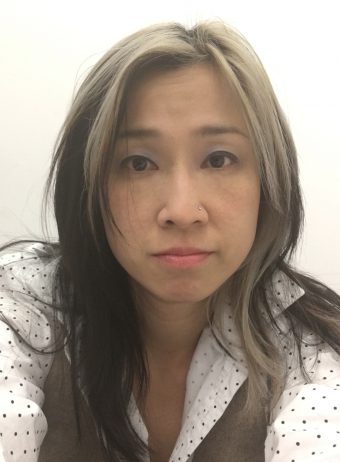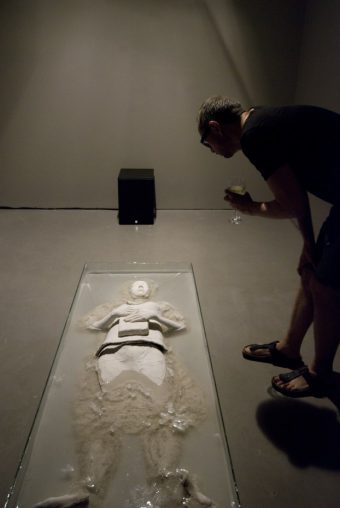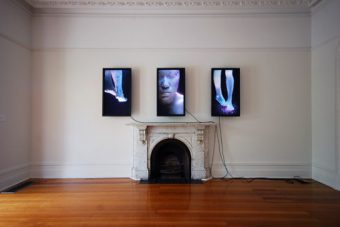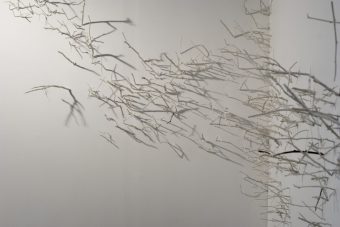
Hong Kong born artist, Cyrus Tang holds a Masters in Fine Arts from Monash University, has undertaken numerous international Artist Residencies, participated in both solo and group art exhibitions – nationally and internationally, and has won a number of prestigious awards for her distinctive artwork, which is largely focused around disintegration and deterioration from a transformational and transcendent perspective.
Tang’s art offers a strange, and all together transfixing experience, a presentation of the slow destruction of everyday items, disintegrating, and deteriorating, which in other circumstances would likely be associated with morbidity. However, Tang manages, instead, to engage the audience to look deeper through a different lens, one that offers an inimitable and transformative perspective – beyond the ordinary view of finalization, it offers the notion of progression and transcendence.
Magdalene H talks to Cyrus Tang about her inspiration, her new art, what she’s been doing since her last interview with Peril, in 2012, and the direction she hopes to see her work lead her into the future.
Magdalene: It’s been five years since you last spoke with Peril, can you tell me about some of the highlights and challenges in your career since that time?
Cyrus: Since 2012, I went to Seoul and Helsinki for a residency funded by Australian Council and Asia link. It was a very fruitful experience. I had a chance to see a range of artworks, and have conversations with other artists, and get to know their practice. It also gave me time to be on my own; I sat down and reviewed my entire art practice and my life.
In Seoul, I developed a new work, Unknown, using human hair. In Helsinki, I produced an installation using strawberry and crystal. I appreciated the opportunity to showcase my work and get some feedback from an overseas audience.
When I returned from Helsinki, in 2013, I made the decision to leave the gallery I had been working with, and branch out as an independent artist, it was an experience that challenged my confidence. I began to wonder if I was good enough to stand up on my own in this way, and that’s when my mind returned to a time earlier in my life, when I changed career from a social worker to an artist. I spent time revisiting and restudying all of the artwork I’d made in the past.
In 2016, I developed a new body of work, Lacrimae Rerum and Encyclopaedia Series. It featured at Arc One Gallery in Melbourne, 2016.

M: When we spoke to you last, much of your work was offered through live exhibitions. However, you briefly mentioned this idea of a ‘strangeness’ in images projected through film. Now, in your most current collaborative work, Assembly Operation, your role is Video Artist, and your work features predominantly through film. Can you tell us about this evolution, from a budding concept to fruition?
C: I don’t see myself as a Video Artist, I would rather the description ‘visual artist’, using video as my medium.
For me, I enjoy the process of transformation of the material. When I reviewed my art practice, it was something that became more and more clear, there was something that just triggered about it, the process of changing and transforming. It’s about time, I think video is a good medium to show the significance of time in our lives.
M: Sound is incorporated as a feature in Assembly Operation, can you tell us how this impacts your work, and the audience’s experience of it?
C: In the past, most of my videos did not incorporate sound, because I wanted the audience to have a moment of silence in order to feel the passing of time through my video work. In the video Body Ruins , I produced the sound installation to go with this video piece ( the water dropping on a hot plate, producing a hissing sound ) . I found something interesting in the dynamic between the visual and auditory elements. They both work together to place an emphases on “time” in different a perspective. That’s part of what influenced my decision to collaborate with Speak Percussion . It is kind of a convergence of the past (video) and the present (Sound).

M: What has inspired you lately?
C: In past projects, I’ve been interested in long exposure photographs, how they capture the entire process of changing/ transformation, and condenses it into a single photograph. From this, I started to investigate this technique relative to human emotion – and if it’s possible to capture people’s reactions and emotions over a period of time, and condense it into a single photograph. We live in a high speed society, and we trend to ignore our emotions and move on with whatever we’re doing. I feel like there is something I would like to share in response to this speedy change of our society. We process huge amounts of information and news every day, and forgot how to digest and how to feel emotionally to this overload of information.
M: What other projects are you currently working on?
C: Parallel with high exposure photographs, I’m also interested in high speed photograph. It is totally opposite from the long exposure photograph. It freezes moments that we can’t capture with our eye, it freezes time. This aspect of it is something that I’m hugely inspired by. Apart from this, I continue to examine burning and cremation. From the Encyclopaedia Series , I maintain the residue of the book ashes after they’ve been cremated at 1280 degrees Celsius . I am fascinated by the visual outcome; The book ashes are a combination of fragility and lastingness. These ideas are about freezing time in different perspectives.
M: Where else might we see your work featured in the coming year?
C: As well as my collaboration with Speak Percussion, Assembly Operation, showing in September, 2017 at Arts House, my work will show at ‘All That is Solid’, at TarraWarra International, alongside other artists, including Patrick Pound, Tom Nicholson Didem Erk (Turkey), Cao Fei (China). The exhibition will run from 2 September, 2017 to 2 November, 2017.
It’s a pleasure that my new sculpture work , The Peasant Boy Philosopher, will exhibit at Sydney Contemporary, at Carriage works, 7 – 10 September, 2017.
I also have a solo exhibition coming up in 2018, at Arc One Gallery, Melbourne.

M: Where do you hope we might find you, in terms of your art, in five years from now?
C: I only take the chances that come to me, but I guess, being of Chinese (Hong Kong) origin, it has always been my dream to have an opportunity to show my work in Hong Kong, and share a bit of me with my home town .

